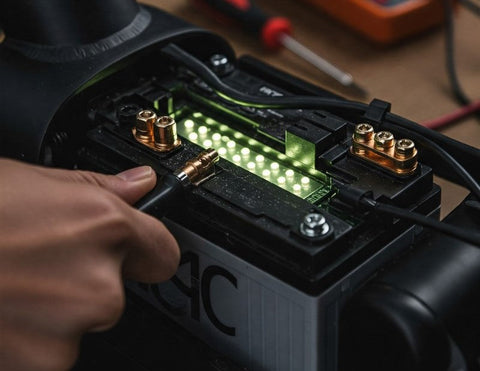As electric bikes (e-bikes) continue to rise in popularity, many first-time riders may find themselves confused about one crucial aspect: the e-bike battery. This essential component powers your bike, giving it that electric boost to help you travel faster and farther. Understanding how e-bike batteries work and how to choose the right one for your bike is key to ensuring a smooth, enjoyable ride.
Whether you're just starting your e-bike journey or upgrading your current bike, this beginner's guide will help you better understand the types of e-bike batteries, their features, and how to maintain them for long-lasting performance.

What Is an E-bike Battery?
An e-bike battery is a rechargeable power source that provides the necessary electricity to run the electric motor on your bike. It is often mounted on the frame, either in the downtube, rear rack, or on the seat tube. These batteries are typically made from lithium-ion (Li-ion) cells, which are known for their lightweight, high energy density, and long cycle life.
There are three primary types of e-bike batteries:
-
Lithium-ion (Li-ion): The most commonly used battery type, offering high capacity, long life, and fast charging times.
-
Lithium Polymer (LiPo): A variant of Li-ion, known for being lightweight and flexible, though it tends to have slightly lower energy density.
-
Lead-Acid: An older, less common technology, heavier and with shorter life expectancy, used in more budget-friendly e-bikes.
The battery powers the motor and controls the amount of pedal-assist you get, or in some cases, the throttle control for a more traditional ride.
How Do E-bike Batteries Work?
E-bike batteries use direct current (DC) to provide energy to the motor. As you pedal, the motor assists in powering your ride, reducing the amount of effort required, especially when climbing hills or traveling long distances. Depending on the level of pedal assist you select, the motor uses more or less power from the battery.
Batteries are typically paired with a controller that regulates how much power is being used and sends the energy to the motor. The system is designed to optimize battery life while providing the level of power you need to enhance your ride.
Key Features of E-bike Batteries

⚡ Capacity and Range
The capacity of an e-bike battery is typically measured in watt-hours (Wh). This number indicates how much energy the battery can store. The higher the Wh, the longer your bike can travel before needing a recharge. On average:
-
250 Wh can take you around 20 to 30 miles.
-
500 Wh can extend your range to 40 to 60 miles.
-
750 Wh and above can reach 70 miles or more, depending on riding conditions.
The range of your e-bike will depend on factors like the terrain, rider weight, riding speed, and assist level. Higher capacity batteries allow for longer distances but may also add more weight to the bike.
🔋 Voltage
The voltage of an e-bike battery typically ranges from 36V to 72V. Higher voltage batteries provide more power, enabling faster speeds and better performance on steep hills. However, they also tend to be more expensive and heavier.
⚖️ Weight
The weight of the battery can impact how comfortable your bike is to ride. While lithium-ion batteries are relatively light, the size and power of the battery will affect the overall weight. It's important to find a balance between power and weight, especially for riders who will use the bike for commuting or long-distance rides.
🔌 Charging Time
Charging time for e-bike batteries varies based on capacity and charger type. A typical battery can take anywhere from 3 to 8 hours to fully charge. Some batteries have a fast-charging option that can reduce charging time significantly.

Tips for E-bike Battery Maintenance
Proper maintenance is crucial to extending the lifespan and performance of your e-bike battery. Here are some tips for keeping your battery in top condition:
-
Avoid deep discharges: Try not to let the battery run completely out of charge. Partial charging is better for long-term health.
-
Store the battery properly: If you’re not using your e-bike for an extended period, store the battery in a cool, dry place, ideally at around 40-60% charge.
-
Regularly charge the battery: Even if you don’t use your e-bike often, it’s a good idea to charge the battery periodically to keep it in good condition.
-
Keep the battery clean: Ensure that the terminals and connectors are free of dirt or corrosion to maintain optimal performance.
Why Choose ChamRider Group?
At ChamRider Group, we specialize in providing high-quality e-bike batteries that deliver both performance and reliability. Our products are designed to give you the range, power, and endurance you need to enjoy your ride for years to come. Whether you’re commuting, mountain biking, or taking long-distance tours, our batteries are made to enhance your riding experience.
Why ChamRider Group?
-
⚡ High-Quality Batteries – Our lithium-ion e-bike batteries are built for long-lasting power and durability.
-
🔋 Wide Selection of Options – We offer a variety of battery capacities, voltages, and designs to suit your specific riding needs.
-
🛠️ Easy Integration – Our batteries are designed to fit seamlessly with most e-bike motors and systems, ensuring smooth installation and compatibility.
-
🌍 Global Reach – We serve customers worldwide, providing reliable e-bike solutions to enthusiasts everywhere.
-
🏆 Industry-Leading Performance – Our batteries are tested for optimal performance and efficiency, ensuring that every ride is as enjoyable as the last.
-
💰 Competitive Pricing – Enjoy top-quality performance at an affordable price, making e-bike conversion accessible to everyone.
Ready to power up your e-bike experience?
Choose ChamRider Group — your trusted partner in high-performance e-bike batteries.
Need assistance or more information?
Contact us today, and let us help you enhance your ride with the perfect e-bike battery solution.




Comments (0)
There are no comments for this article. Be the first one to leave a message!